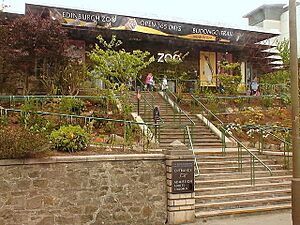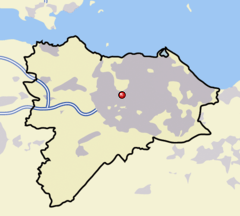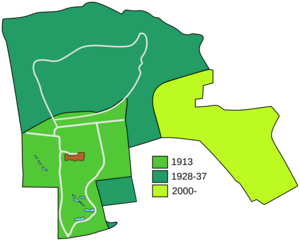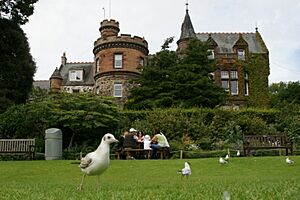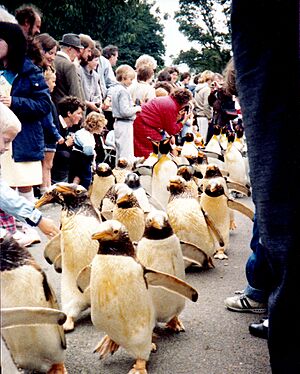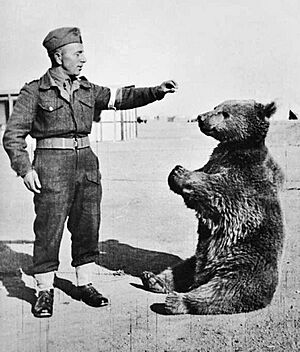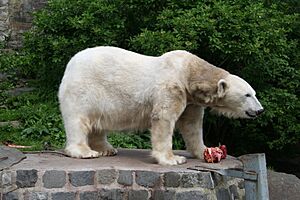History of Edinburgh Zoo facts for kids
Edinburgh Zoo is a fun zoological park located in Corstorphine, Edinburgh, Scotland. It first opened its doors on 22 July 1913. This amazing zoo is owned and run by the Royal Zoological Society of Scotland. When it first started, it was called the Scottish National Zoological Park. Thanks to new ways of caring for animals, even tropical animals could live well in Edinburgh's cooler weather.
Edinburgh Zoo is special because it's the only zoo in the United Kingdom to have a royal charter. This means it has a special approval from the King or Queen! It was also the very first zoo in the world to have and breed penguins. The zoo's penguins are super famous, and since the 1950s, they've had a daily parade around the park.
The zoo managed well during wars, though some animals had to be moved for safety during the Second World War. After the war, a brown bear named Wojtek, who had served with the Polish army, came to live there. Later, in 1972, one of the zoo's king penguins was even adopted by the Norwegian military!
In the 2000s, Edinburgh Zoo had to close for a short time because of the 2001 foot-and-mouth outbreak. In 2005, it also received threats from a group called the Animal Liberation Front. Around 2000, the zoo started a big plan to make the whole park even better.
Contents
Early Zoos in Scotland
Scotland actually had a zoo before Edinburgh Zoo. It was called The Royal Edinburgh Zoological Gardens and opened about 70 years earlier. This old zoo was built in the gardens of a country house called Broughton Hall. It was about six acres big and located near Central Edinburgh.
Back then, animals in zoos often lived in small, crowded cages. The old Zoological Gardens were no different. Because of this, the animals often got sick and suffered from Edinburgh's cold winds. To try and stay popular, the zoo put on concerts, acrobatics, and even fireworks shows. Kids could even ride on the back of the zoo's elephant! But even with all these fun things, the old zoo eventually closed in 1857. Today, nothing is left of it.
How Edinburgh Zoo Began
Edinburgh Zoo was the dream of Thomas Haining Gillespie, a lawyer from Dumfries. He really wanted to create a zoo in Scotland. At first, people told him that animals from warm places could never live in a cold city like Edinburgh. This was partly true because of what happened to the old Royal Zoological Gardens. But in 1908, he learned about new ideas from Carl Hagenbeck. Carl Hagenbeck was making it possible for tropical animals to live well in his zoo in Hamburg, Germany.
In 1909, Gillespie and his friends started a group that became the Royal Zoological Society of Scotland. This group's first president was a lawyer named Edward Theodore Salvesen. His family had a connection to Norway, which would be important later on.
Next, they needed to find the perfect spot for the new zoo. Gillespie wanted a sunny place, protected from cold winds. He also wanted it to be easy to reach by public transport. The society found the Corstorphine Hill House estate, which was about 75 acres big. They had an option to buy it for £17,000.
The society had trouble raising all the money in time. So, the Edinburgh City Council stepped in and bought the land in February 1913. The zoo society could use the land if they paid back 4% of the cost each year.
Another £8,000 was raised to build the park and get animals. At first, the zoo only used about 27 acres, and the land to the north was a golf course. The park was designed by Patrick Geddes and his son-in-law Frank Mears. They designed it to be open and natural, like the New York Zoological Park and Hagenbeck's zoo. This was very different from the small, steel cages common in zoos before. The Scottish National Zoological Park, as it was first called, opened on 22 July 1913. It had many donated and borrowed animals, and it took only 15 weeks to build! The zoo still uses much of this same land today.
Early Years of the Zoo
In its first year, the zoo received a royal charter. This special document meant it had royal approval. However, it wasn't allowed to use the "Royal" title until 1948, after King George VI visited. As of 2011, Edinburgh Zoo was the only zoo in Britain with a royal charter. The charter said the zoo's job was to teach people about animals and encourage them to learn about wildlife.
Thanks to the Salvesen family's connection, some of the zoo's first animals were three king penguins. They arrived from South Georgia in early 1914 with a Christian Salvesen whaling ship. These were the first penguins ever seen outside of the South Atlantic! The zoo even successfully hatched the first ever king penguin chick born in a zoo in 1919. Penguins kept arriving with whaling ships for many years. Today, king penguins are probably the zoo's most famous animals.
In 1925, a house for tropical birds and reptiles was added. An aquarium, paid for by a grant, opened in 1927, and an ape house in 1929. The famous penguin pool was built in 1930, though it was rebuilt in 1990 with a new viewing area. In 1928, the golf club finally moved out of the northern 47 acres, allowing the zoo to get much bigger. This new part of the park was also designed to be open and natural.
Hagenbeck's modern zoo ideas worked very well. Edinburgh quickly became known for treating its animals well. In 1934, a sea lion and a beaver were born at the zoo. In 1936, a baby chimpanzee was born, followed by wolves in 1938. Soon after, the first orangutan born in Britain arrived!
During the Wars
Edinburgh Zoo was hit by bombs twice during the Second World War, but it wasn't badly damaged. One bomb, around 1940, was said to have killed a giraffe. Like all zoos in Britain, the war affected Edinburgh Zoo. Even with the war, the zoo kept growing. Land to the east was bought in 1942, and building a lake started soon after.
After the War
The famous Penguin Parade started around this time. A zookeeper accidentally left a gate to the penguin pool open, and the penguins followed him around the zoo! Visitors loved seeing this so much that it became a regular event. Today, about two-thirds of the zoo's penguins parade around the park every day.
One of the zoo's most famous animals after the war was Wojtek, a Syrian brown bear. Wojtek was sold to Polish soldiers during the war. He learned to help them carry ammunition boxes and became their unofficial mascot. In 1944, he even had to be officially made a soldier to travel with them! In 1946, the Polish soldiers settled in Scotland, and Wojtek retired to Edinburgh Zoo in 1947. He lived there until 1963. While in the army, the bear had learned to like cigarettes, which made him even more popular at the zoo!
In 1972, the zoo got even more military fame when a king penguin named Nils Olav was adopted by the Norwegian King's Guard. This connection started with the Salvesen family's links to the zoo. A lieutenant named Nils Egelien visited the zoo in 1961 and later arranged for his unit to adopt a penguin. Nils Olav was named after the lieutenant and King Olav V of Norway. He was even given the rank of lance corporal! A statue of the penguin now stands outside the zoo.
A three-year-old polar bear named Mercedes came to the zoo in 1984. She was rescued in Canada after she started wandering into a town looking for food. She was a danger to people, so a decision was made to shoot her. But a member of the Edinburgh Zoological Society worked with a relative in Canada to rescue Mercedes and bring her to Edinburgh Zoo. She became one of the zoo's most popular animals.
In 1986, the zoo society bought the Highland Wildlife Park. This is a 259-acre safari park and zoo near Kingussie. When it opened in 1972, its goal was to show animals native to the Highlands of Scotland. Today, it focuses on animals that live in cold, snowy places, like the tundra. Some animals from Edinburgh Zoo have even moved there.
Edinburgh Zoo in the 2000s
In 1999, the zoo thought about moving to a new location to make its facilities better. But by February 2000, they decided not to move. Instead, they announced a "masterplan" to rebuild and improve the entire zoo site.
The foot-and-mouth scare of 2001 forced the zoo to close to protect the animals from getting sick. Since no visitors could come, the zoo lost a lot of money. People wondered about the zoo's future, but it was able to reopen after only five weeks. An anonymous person donated £1.9 million in early April, which helped the zoo a lot.
In 2005, the new Budongo chimp house opened. Also, the Living Links to Human Evolution Centre opened, which is Britain's first place for studying how primates behave. In 2006, scientists at Edinburgh Zoo made a big discovery: chimpanzees there were found to use sounds like "words" for food!
In late 2005, the Animal Liberation Front (ALF) threatened action because Mercedes, Britain's only polar bear at the time, was kept in captivity. The zoo had planned to stop having polar bears after Mercedes passed away. But when zoo officials announced plans for a new polar bear exhibit, saying they needed to help save the species, the ALF made threats. Edinburgh's care of polar bears had sometimes been criticized. For example, Mercedes' partner, Barney, died in 1997 after choking on a plastic toy thrown into his enclosure. In 2009, the zoo went ahead with plans for a new exhibit and better conditions for Mercedes. She moved to the Highland Wildlife Park, where she was joined by a young male polar bear named Walker. Mercedes passed away in 2011 from severe arthritis.
Zoo Plans and Council Decisions
In January 2006, the zoo proposed selling about 15 acres of land to raise money for its big redevelopment plan. However, the council rejected these plans in October 2007 by just one vote. The zoo was very disappointed.
In November, the zoo announced it would try to fight the council's decision. A rumor spread that the zoo might move to Glasgow, but zoo officials said this wasn't true. After a lot of discussion, the zoo was allowed to sell only a small part of the land it originally wanted to sell.


